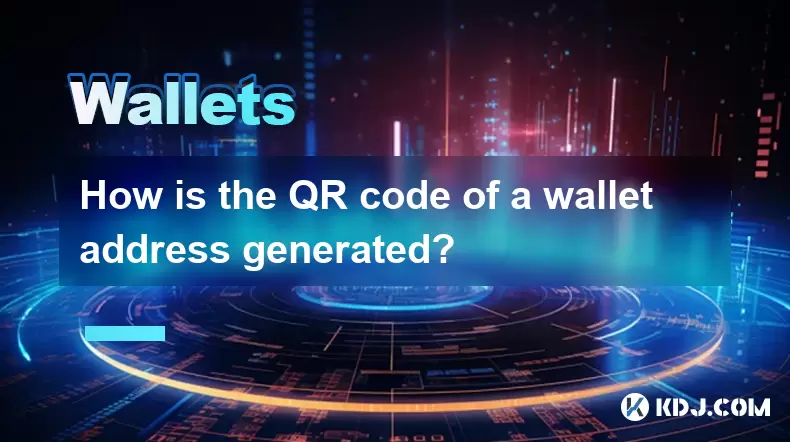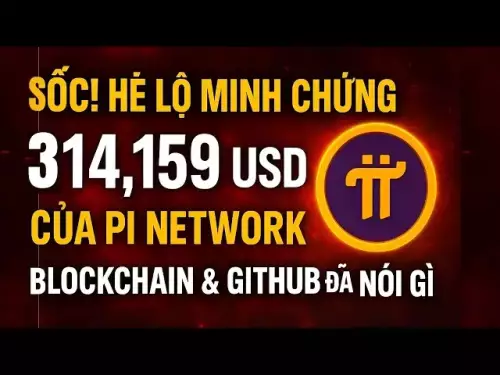-
 bitcoin
bitcoin $109547.008142 USD
0.04% -
 ethereum
ethereum $4011.838726 USD
-0.05% -
 tether
tether $1.000402 USD
-0.01% -
 xrp
xrp $2.798606 USD
0.88% -
 bnb
bnb $970.877944 USD
1.39% -
 solana
solana $202.237275 USD
-0.95% -
 usd-coin
usd-coin $0.999673 USD
0.00% -
 dogecoin
dogecoin $0.229294 USD
-1.15% -
 tron
tron $0.336370 USD
-0.45% -
 cardano
cardano $0.777260 USD
-1.66% -
 hyperliquid
hyperliquid $45.503019 USD
1.73% -
 ethena-usde
ethena-usde $1.000362 USD
0.01% -
 chainlink
chainlink $20.785303 USD
-1.10% -
 avalanche
avalanche $28.755822 USD
-0.11% -
 stellar
stellar $0.358303 USD
-0.48%
How is the QR code of a wallet address generated?
A wallet address is a unique identifier derived from cryptographic keys, used to send and receive cryptocurrencies securely on blockchain networks.
Jun 13, 2025 at 10:49 pm

Understanding the Basics of a Wallet Address
A wallet address is a unique identifier used in blockchain networks to send and receive cryptocurrencies. It is derived from a pair of cryptographic keys — a private key and a public key. The private key is kept secret and grants control over the funds, while the public key is used to generate the wallet address. This address is what users share with others to receive crypto payments.
The wallet address is typically represented as a string of alphanumeric characters. However, for convenience and error prevention during transactions, this string is often converted into a QR code, which can be easily scanned using mobile or desktop wallets.
The Role of QR Codes in Cryptocurrency Transactions
A QR (Quick Response) code is a two-dimensional barcode that can store data such as text, URLs, or other information. In the context of cryptocurrency, QR codes are used to represent wallet addresses visually. They eliminate the need to manually enter long alphanumeric strings, reducing the risk of typos and incorrect transfers.
When a user generates a QR code for their wallet address, they are essentially encoding the address into a scannable image. Wallet applications and online tools use specific algorithms to convert the wallet address into binary data, then format it into a matrix barcode that scanners can interpret accurately.
Step-by-Step Process to Generate a QR Code for a Wallet Address
To create a QR code for a wallet address, you must first ensure that the wallet address is correctly formatted and verified. Once confirmed, the following steps outline how the QR code is generated:
- Obtain the wallet address: This can be copied directly from your wallet interface.
- Choose a reliable QR code generator: Many online tools and libraries exist, such as QRCode.js, ZXing, or built-in features within wallet apps.
- Input the wallet address into the generator: Paste the address into the designated input field.
- Select appropriate encoding options: Most generators allow customization like size, color, and error correction levels.
- Generate and download the QR code: After processing, the tool outputs the QR code image in formats like PNG or JPEG.
Some advanced tools also allow embedding logos or branding elements into the QR code without compromising its functionality.
Technical Aspects Behind QR Code Generation
Underneath the surface, generating a QR code involves several technical layers. First, the wallet address undergoes UTF-8 encoding, converting the string into binary data. Next, the QR code generator applies error correction algorithms (like Reed-Solomon coding), ensuring that even if part of the image is damaged, the data can still be recovered.
The binary data is then mapped onto a grid of black and white squares, forming the recognizable QR matrix pattern. The version of the QR code (ranging from 1 to 40) determines the grid size and data capacity. For standard wallet addresses, versions 1 through 5 are usually sufficient.
Each QR code also includes position detection patterns, timing patterns, and format information to help scanners align and decode the image accurately.
Security Considerations When Using QR Codes
While QR codes offer convenience, they also pose potential security risks. A malicious actor could replace a legitimate QR code with one pointing to their own wallet address. Therefore, it's crucial to verify the contents of a QR code before scanning, especially when receiving large sums.
Additionally, always ensure that the QR code generation tool is trustworthy. Open-source libraries like ZXing or qrcode npm packages are preferred because their source code can be audited for security flaws. Avoid using unknown third-party websites that may log or manipulate the data being encoded.
If possible, cross-check the generated QR code by scanning it with a separate device or application to confirm that it resolves to the correct wallet address.
Frequently Asked Questions
Q: Can I generate a QR code offline without using online tools?Yes, you can generate a QR code offline using open-source libraries or software installed locally on your computer. Tools like QRCode.js or Python’s qrcode library allow you to generate QR codes programmatically without an internet connection.
Q: What happens if the QR code gets damaged or partially obscured?Modern QR codes include error correction mechanisms that allow them to remain scannable even if up to 30% of the image is damaged or missing. The level of resilience depends on the selected error correction mode during generation.
Q: Is there a difference between a wallet address QR code and a transaction QR code?Yes, a wallet address QR code only contains the recipient’s public address. In contrast, a transaction QR code may include additional parameters like amount, message, or network type (e.g., testnet vs mainnet). These extra fields enable direct sending without manual entry.
Q: Are all wallet addresses compatible with QR code generation?Most modern wallet addresses are fully compatible with QR code generation. However, certain legacy formats or exotic blockchain protocols might require special handling or conversion before they can be encoded properly. Always verify compatibility with your chosen QR code generator.
Disclaimer:info@kdj.com
The information provided is not trading advice. kdj.com does not assume any responsibility for any investments made based on the information provided in this article. Cryptocurrencies are highly volatile and it is highly recommended that you invest with caution after thorough research!
If you believe that the content used on this website infringes your copyright, please contact us immediately (info@kdj.com) and we will delete it promptly.
- Ethereum, Bitcoin Dominance, and the Altcoin Rally: A New York Minute on Crypto
- 2025-09-28 12:25:15
- RLUSD, XRP, and Open Interest: Decoding the Dynamics
- 2025-09-28 12:25:15
- Crypto Meme Coins: Unveiling the 2025 Potential
- 2025-09-28 12:25:16
- Crypto's Comeback: Solana, Polygon, and the Hunt for the Next Moonshot
- 2025-09-28 12:25:16
- Stablecoins, Financial Transactions, and the Future World: A New York State of Mind
- 2025-09-28 12:30:12
- XRP, Competitor, PDP Climb: Decoding the Crypto Landscape in 2025
- 2025-09-28 12:30:12
Related knowledge

How do I view smart contract interaction history in Coinbase Wallet?
Sep 24,2025 at 01:36am
Accessing Smart Contract Interaction History in Coinbase Wallet1. Open the Coinbase Wallet application on your mobile device and log in using your cre...

How do I use the token swap feature in Coinbase Wallet?
Sep 24,2025 at 05:00pm
Understanding Token Swaps in Coinbase Wallet1. The token swap feature in Coinbase Wallet enables users to exchange one cryptocurrency for another dire...

How do I participate in governance voting in Coinbase Wallet?
Sep 25,2025 at 01:55pm
Understanding Market Volatility in the Crypto Space1. Cryptocurrency markets are known for their extreme price fluctuations, often driven by sentiment...

How do I set up a custom RPC node in Coinbase Wallet?
Sep 24,2025 at 12:00pm
Understanding Custom RPC Nodes in Coinbase Wallet1. A custom RPC (Remote Procedure Call) node allows users to connect their Coinbase Wallet to a block...

How do I manage multiple assets in Coinbase Wallet?
Sep 23,2025 at 10:00am
Understanding Multi-Asset Support in Coinbase Wallet1. Coinbase Wallet allows users to store a wide variety of digital assets beyond just Bitcoin and ...

How do I connect Coinbase Wallet to a hardware wallet?
Sep 26,2025 at 02:54am
Connecting Coinbase Wallet to a Hardware Device1. Open the Coinbase Wallet app on your mobile device and ensure it is updated to the latest version. N...

How do I view smart contract interaction history in Coinbase Wallet?
Sep 24,2025 at 01:36am
Accessing Smart Contract Interaction History in Coinbase Wallet1. Open the Coinbase Wallet application on your mobile device and log in using your cre...

How do I use the token swap feature in Coinbase Wallet?
Sep 24,2025 at 05:00pm
Understanding Token Swaps in Coinbase Wallet1. The token swap feature in Coinbase Wallet enables users to exchange one cryptocurrency for another dire...

How do I participate in governance voting in Coinbase Wallet?
Sep 25,2025 at 01:55pm
Understanding Market Volatility in the Crypto Space1. Cryptocurrency markets are known for their extreme price fluctuations, often driven by sentiment...

How do I set up a custom RPC node in Coinbase Wallet?
Sep 24,2025 at 12:00pm
Understanding Custom RPC Nodes in Coinbase Wallet1. A custom RPC (Remote Procedure Call) node allows users to connect their Coinbase Wallet to a block...

How do I manage multiple assets in Coinbase Wallet?
Sep 23,2025 at 10:00am
Understanding Multi-Asset Support in Coinbase Wallet1. Coinbase Wallet allows users to store a wide variety of digital assets beyond just Bitcoin and ...

How do I connect Coinbase Wallet to a hardware wallet?
Sep 26,2025 at 02:54am
Connecting Coinbase Wallet to a Hardware Device1. Open the Coinbase Wallet app on your mobile device and ensure it is updated to the latest version. N...
See all articles










































































